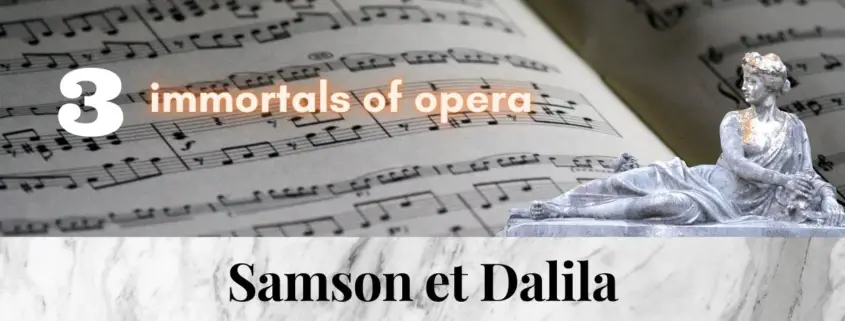3 immortal pieces from the opera SAMSON ET DALILA by Saint-Saens- with the best interpretations from YouTube (Hits, Best of)
Samson et Dalila is one of the 5 greatest works of French opera literature. Three immortal arias for mezzo-soprano, the overwhelming Bacchanale, an attractive tenor role and the great choruses leave lasting impressions. The second act shows the greatest emotions and passions.
Dalila’s Great Plea to the God of Love
A restless introduction shows Dalila’s agitation; revenge is her goal. The challenge of this aria is to keep the beautiful prayer to the God of love feminine despite the vengeful text (he is my slave; pour the poison into his veins) and the low passages.
No one could make the supplication as forceful as Maria Callas.
Samson, recherchant ma présence … Amour! viens aider ma faiblesse! – Maria Callas
The great seduction scene – Mon coeur s’ouvre à ta voix
Saint-Saens wrote no less than three great, immortal arias for the role of Dalila. This aria is one of the most beautiful and seductive arias in the entire operatic repertoire.
Dalila wants to seduce Samson out of raison d’état, but one senses that there is more behind her seductive promises. She may not be in love with Samson, but she does have feelings for him. She tries to seduce Samson with her warm, erotic voice. The orchestra’s accompaniment is delicate, at times playful, and dispenses entirely with brass and percussion instruments.
Saint-Saens’ performance designation is “dolcissimo e cantabile.” The voice and orchestra shine in luminous major. The orchestra plays swelling and decaying chords that imitate a gentle, billowing breeze, an allegory for beauty and seduction.
But Dalila has not yet reached her final destination. She must get behind Samson’s secret. Sweetly, almost pleadingly, she asks Samson to speak to her, to dry her tears. The tone becomes more urgent and she repeats the ecstatic “versez moi l’ivresse” (“Fill me with happiness”) with which she wants to win Samson. A beautiful passage from the clarinet takes up the theme in a painfully sweet manner. The second part once again takes up the themes of the first part. The sound of the orchestra changes more and more with seductive oriental figures until the western harmonies are heard again in the last part. At the end, Samson surrenders, the piece becomes a duet, and he pines “Dalila, je t’aime” several times.
See a great excerpt with Olga Borodina and Placido Domingo
Mon coeur s’ouvre à ta voix – Borodina / Domingo
The famous Bacchanale – oriental sounds
With the Bacchanale, Saint-Saens wrote a ballet as an unleashed erotic painting. Fueled by the energetic music, the guests begin their ecstatic dance.
The ballet begins with an oboe introduction. The music is written in Phrygian major (the Jihaz), a scale common in Oriental music.
Saint-Saens imitated half a dozen ancient Arabic instruments in the Bacchanale (and throughout the opera). The oboe introduction recalls the sound of a shawm, the harp imitates a qunan, and the strings played pizzicato imitate an oude, a lute-like guitar with a bent neck plucked with a plectrum still in use today.
In a second part, the music becomes European, waltz-like to then return to the world of the first part.
The Bacchanale is distantly reminiscent of the Venusberg scene from Tannhäuser, and was surely an inspiration for Strauss’s “Dance of the Seven Veils” from Salome in2222.
Hear and see a magnificent Bacchanale in a Met production.
Bacchanale – Levine






Leave a Reply
Want to join the discussion?Feel free to contribute!